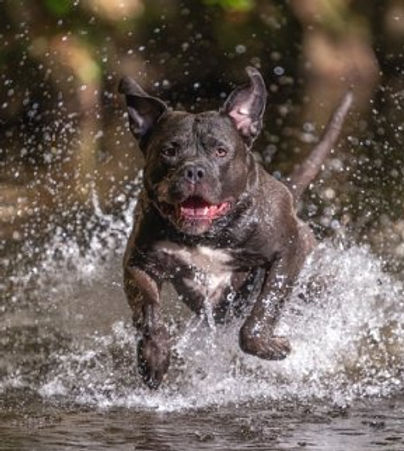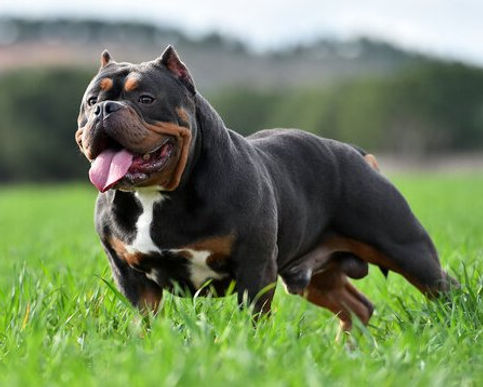
American Bully
The American Bully is a relatively new dog breed that has gained popularity for its muscular build, friendly demeanor, and versatility as a companion. Originating in the United States in the late 20th century, it is a mix of various bull breeds, including the American Pit Bull Terrier and the American Staffordshire Terrier, aimed at creating a more stable and companionable dog. Known for their loyalty and affection towards families, American Bullies come in different sizes and varieties, such as Standard, Pocket, and XL, showcasing a unique blend of strength and sweetness. However, potential owners should be aware of responsible breeding and socialization practices to ensure a well-adjusted pet.
American Bullies are exuberant, active, adventurous dogs, and they can, with diligent training and responsible training, serve as loving pets. They thrive on activity and interaction, adapting well to various lifestyles while showcasing their playful and adventurous nature.
The American Bully thrives under a consistent, assertive training approach and benefits from regular physical exercise along with mental challenges to keep them engaged and healthy. This breed is known for its loyalty and intelligence, making it important for owners to maintain a structured environment that meets their exercise needs while also providing positive reinforcement for good behavior.
The American Bully's history can be traces back to the late 20th century, specifically in the 1980s, when breeders aimed to create a companion dog with a muscular build and a gentle temperament. The breed emerged from a combination of American Pit Bull Terriers, American Staffordshire Terriers, and other breeds, with the goal of producing a family-friendly dog that displayed the physical characteristics of its bull breed ancestry while minimizing the aggressive traits.

There is consensus that at least five other breeds were used to attain the physical traits desired as well as the more diminutive size of some blood lines. The American Pit Bull Terrier (APBT) was the foundation (parent breed) used to create the American Bully. The APBT has maintained a characteristic appearance and temperament for over a century,with different strains of APBT emerging within the breed, each with different physical attributes. One particular APBT strain was crossbred to create a stockier physique that breeders originally misrepresented as purebred APBTs.
Adult American Bully Enjoying The Day
History Of The American Bully
Eventually, enough breeders agreed that these dogs were disparate enough from APBTs that they should be called a different breed altogether. The bloodline of these mixed breeds was further influenced with openly-acknowledged breeding with the American Bulldog, English Bulldog, and Olde English Bulldogge in order to fine-tune desired physical characteristics and personality traits.
American Bullies Dog Breed
The American Bully Kennel Club divided the American Bully into four categories, including the XL, Pocket, Standard, and Classic.
- The "standard" American Bully type is a medium-sized dog with a compact bulky muscular body, heavy bone structure and blocky head. Male dogs must be 17 to 20 in (43 to 51 cm), while females must be 16 to 19 in (41 to 48 cm) at the withers.
- The "pocket" type is a smaller variant, with full-grown males 14 to 17 inches (36 to 43 cm), and females 13 to 16 inches (33 to 41 cm), at the withers.
- An XL type is determined by its adult height, with males 21 to 23 inches (53 to 58 cm), and females 19 to 22 inches (48 to 56 cm), at the withers.
- The "classic" is a lighter-framed dog than the standard, but falls within the same height range. These dogs do not display the exaggerated features often found in the other varieties, and display clearer American Pit Bull Terrier and American Staffordshire Terrier lineage.
Physical Characteristics
With great muscle often comes the question of health. While American Bullies are generally hardy dogs, they are not free from some breed-specific health concerns. Hip dysplasia, elbow dysplasia, and certain heart conditions can affect them if not responsibly bred. Because temperament is also a priority in breeding, you’ll find that reputable breeders prioritize not only physical traits but also health screenings and genetic testing to ensure their pups grow into strong, happy adults.
The coat is short, smooth, and glossy, coming in various colors and patterns,with a broad deep chest, and muscular legs.

American Bully with Cropped Ears
Temperament
The American Bully is often misunderstood due to its muscular appearance and stigma surrounding bully breeds. However, they are known for their affectionate, loyal, and friendly temperament.With proper socialization and training, American Bullies can be gentle and playful companions, exhibiting a strong bond with their families.
Despite their intimidating looks, American Bullies are known for their gentle and loyal temperament. They thrive on human attention and typically get along well with children and other pets if socialized properly from an early age. Their intelligence and eagerness to please make them excellent candidates for training and bonding activities.
This breed tends to be confident without being aggressive, making them superb family companions and eager participants in dog sports like obedience, weight pulling, or agility. But, of course, every dog has its own personality, and early socialization coupled with consistent training is key to bringing out the best in these muscular charmers.
Health Issues

Hip and Elbow Dysplasia: These conditions are common in many large-breed dogs, including American Bullies, and can cause joint pain and mobility issues.
-
Skin Allergies: American Bullies can be prone to allergies, leading to skin irritation, itching, and redness.
-
Brachycephalic Airway Syndrome: Their short muzzles can cause breathing problems, such as snoring, wheezing, and difficulty exercising.
-
Heart Disease: American Bullies can be susceptible to congenital heart conditions.
Adult Tri Color Male American Bully
Unfortunately, the unique body structure of bulldogs means they're prone to some health issues like breathing problems, hip dyspepsia, and Skin Allergies, so they need an owner who's prepared to give them extra TLC.
- Brachycephalia: Meaning a shortened head and face, is a characteristic of bulldogs, particularly English and French Bulldogs, and it leads to a condition called Brachycephalic Obstructive Airway Syndrome (BOAS) due to anatomical issues affecting breathing. Though not as common in American Bulldogs.
- Hip dysplasia, is a condition where the hip joint doesn't develop properly, resulting in a shallow socket that the ball (femoral head) doesn't fit into correctly. This loose joint can lead to subluxation (partial dislocation) and, over time, significant pain and osteoarthritis (arthritis). It's a hereditary condition, meaning it's passed down through genetics.
- Bulldogs have nearly three times greater risk of patellar luxation. When the kneecap (patella) dislocates or "pops out" of its groove in the femur (thigh bone).
- Cherry Eye: A condition where the third eyelid prolapses, causing a visible pink or red swelling in the eye.
- Hypothyroidism: This thyroid disorder can cause weight gain, lethargy, and skin issues.
Reputable - Ethical Breeders Are Key
So, what’s the final scoop on the American Bully? It’s a breed that breaks the stereotype—born from the world of bulls and terriers but bred to be a gentle, reliable companion with a powerful appearance. For those seeking a dog that’s both protective and playful, strong and sweet, the American Bully could just be the perfect fit.

Only buy a bulldog from a reputable breeder, who prioritizes the health and well-fare of their dogs. Read our tips on 'puppy mill' puppies.
